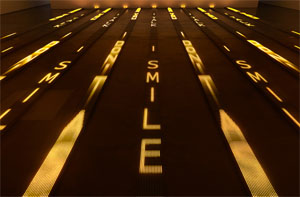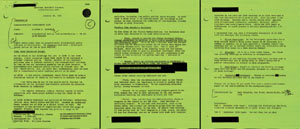Two Kinds of Overload
John Haberin New York City
Jenny Holzer: PROTECT PROTECT
Jenny Holzer's retrospective, "PROTECT PROTECT," has relatively few works. All date from the last fifteen years, with the stark familiarity of the headlines. They let torturers and their victims speak, and the former plead the most. They include the plain text and images of declassified documents, displayed in LED and silkscreens. They are overwhelming, but also intimate and often funny. 
That overwhelming sensation depends on both factual and sensual overload. The two, in fact, are intertwined. Human beings do not cope well with pain or death. Americans can hardly cope with the last eight years without anger or evasions in place of calm, rational arguments. Holzer gives that failure visual expression.
The show overwhelms such oppositions as political art and purity, painting and new media, art and text. (An earlier review of mine looks at her work as a test case of art and text.) One of oldest works on display, Lustmord, could translate as rape-murder, but also as sex and death. It consists of a table of human bones, chillingly clean, each with text on a silver band. It could come right out of the tabloids, grand opera, a mass grave, or a natural-history museum, but no one is saying. In this context, the Freedom of Information Act is a compendium of censorship, and censorship is a form of expression.
Facts and sensations
Jenny Holzer has high standards for democracy, and she holds art to the same standards. She expects transparency, but she knows that decisions take place in confinement or in secret. She expects responsibility, but she knows that people suffer alone. She expects words to mean what they say, almost like Mel Bochner. She expects clarity and publicity, but she knows that abuses have consequences not so easy to understand. They become overwhelming.
Silkscreens retain the blanks and black marks of military and executive "redaction." Crawl screens substitute rows of the letter X. In two canvases, nothing remains but large black fields and echoing black fringes—the result of stacked photocopies. With others, the eye ricochets from white trapezoid to white trapezoid, barely unable to grasp the text. On a full wall, black squiggles efface the hand prints of military personnel. The squiggles reinforce the black silhouettes, while covering up their uniqueness.
The hand prints come from U.S. military investigations into crimes of war. Across from them, LEDs take their text from the same official materials. The silkscreens hang on the wall like fine art, while the crawl screens stick to floor level, in parallel arcs. The text continues on the underside or inside of the implied tube, but one cannot make much out on either side. The plain text becomes more ominous, more self-generating, and less accountable than the blackness. Perhaps the investigations, the evasions, and the circular motion alike will continue without ending.
Other text, in contrast, positively begs for readers. In one room, the tortured speaks, both in his own words and in autopsy reports. In another work, the anonymous voice could belong to a parent or lover. I cover you I shelter you I work the pause in the night . . . Before you die I see your body on your bed in the light . . . I cannot breath. Holzer's capital letters, which I do not reproduce here, and her distaste for punctuation could stand for the loss of emotional boundaries in a confession.
Still elsewhere, the perpetrators ask for a hearing in their own handwriting. A mother pleads for her son in the service. A soldier implicated in a "masacre" pleads that "we never went into a neighborhood and completely leveled it." One could easily miss that "I personally killed a child." In a White House memo disavowing the Geneva conventions, a full year before the Iraq war and before even the infamous John Yoo torture memo, one can decipher everything but George W. Bush's signature. It could be the scrawl of a gullible child or a casual killer.
Most often, redaction extends only to an individual's identity. Like the black hands, each room is recognizably the artist's fingerprint and the fingerprint of others, but also a refusal of both. At the same time, it invites lingering, meditation, and openness. The crawl screens provide most of the illumination, and they color the off-white ground of the canvases. Next to the black and white fields, the Whitney's trapezoidal windows look startling—like one more enclosure or revelation. Formalism lives on, as both a confrontation with reality and a fear of its consequences.
Content and form
Fact and sensation parallel content and form—or text and art, in what another show has called "Drawing Time, Reading Time." One gets so tied up in reading that one can forget the work is about anything but words. Just quote the headlines. It can suggest a style as heavily literal as for Hans Haacke, Emory Douglas, Emily Jacir, R. Luke DuBois, or Marlene Dumas. It can also seem to reinforce a postmodern critique of art as a visual language or sign system. All that is well and good, but it leaves out the overwhelming part.
 Holzer's 2006 redaction paintings forced one to acknowledge art as text. Now, art is not a language, not even for a poet of Surrealism in thread like Mira Schendel. However, art as text is a powerful metaphor for understanding art. Art exceeds text—and that produces new readings and new art. A shared form shapes private imaginings, and these shape public discourse. That is why the personal and the political leave a space for political art and for art criticism.
Holzer's 2006 redaction paintings forced one to acknowledge art as text. Now, art is not a language, not even for a poet of Surrealism in thread like Mira Schendel. However, art as text is a powerful metaphor for understanding art. Art exceeds text—and that produces new readings and new art. A shared form shapes private imaginings, and these shape public discourse. That is why the personal and the political leave a space for political art and for art criticism.
All that fancy, compressed argument aside, Holzer makes the most of the confusion. The more I try to describe the work, the more I have to quote it. And the more I quote it, the more I have to describe how she makes it. She keeps insisting that she is painting these days. It sure sounds like special pleading except that she is. Or maybe she is, but especially when refusing to paint.
She has turned more in the last few years to silkscreens. The canvas sticks to shades of black and white, while the LEDs color the canvases and the walls. They also reflect off the windows at night and grow visible from the street. The canvases also stick to the official redactions. They even retain the tilt of photocopied documents. With their appropriations, smears, and the subject of disaster, they follow Andy Warhol—but only to blacken their model.
Holzer gave up painting the old-fashioned way in 1977 (as Andy Warhol briefly did, for all Warhol's influence), with crude crawl screens that blended into public places and stuck out in galleries. She became part of two quite distinct movements. Her use of new media has a parallel in other political and feminist artists, such as Barbara Kruger. However, Kruger's texts seem delivered from on high, like her vision of corporate America. In her most famous image, the words cross God's own finger, in the creation of man by Michelangelo. Holzer's sources range from the daily papers to her imagination.
She also aligned her art with Minimalism. Industrial components cling to the walls and floor, as with Donald Judd and Carl Andre. A stairway of light fixtures, Red Yellow Looming, draws on Dan Flavin and François Morellet. However, she alters her model in pursuit of confinement and overload. One cannot take art as object apart from text. One also cannot step on her floor pieces without breaking them, and one has to circumvent that wall of light via another room. By then one is tempted in other directions, and the looming has changed from bright yellow to bright red.
Retrospective and looming
The show has two last kinds of overload—the sudden moment and the final accounting. It makes its most overwhelming sensation right off the Whitney's elevator bank. Eleven huge LEDs stream across the floor from left to right. Their amber dots form ominous phrases, like still more defenses of Abu Ghraib. One can walk around them, to read them more easily, but then they vanish into the far wall. One may not dare to enter the narrow space behind them, which holds the back side of Red Yellow Looming.
One has plenty of other adjustments to make. In a corner piece, horizontal crawl screens alternate angles off 45 degrees, so that they appear tilted and in danger of colliding. Still, the entire installation is an overwhelming accumulation of evidence. That evidence includes Holzer's career. The opening work, For Chicago, repeats the text of Holzer's early work, and Red Yellow Looming uses documentation of the first Gulf War. She has ripped art out of the headlines and out of her past.
The Whitney calls this a retrospective of just fifteen years, already a contradiction in terms. Even then, almost everything dates from 2008—two years after a gallery showed her censorship paintings. It also skips recent work further from war, including poetry projected onto New York landmarks. The oldest work in the show, three benches of polished granite from 1989, seems chosen for its relevance to the Bush years. According to the text carved in one, "It takes a while before you can step over inert bodies and go ahead with what you are trying to do." The sole other past work, from 1994, sets out the human bones—its theme, Holzer drily notes, "courtesy of the war in Yugoslavia.
All the same, the retrospective spans her career, its media, and its words. Holzer, who could easily belong with other wordsmiths in "The Pictures Generation," goes back thirty years and bring them up to the minute. She has even had to reinvent For Chicago, which took two rooms at Chicago's Museum of Contemporary Art. She has those granite benches midway through, she explains, just in case anyone needs a rest. New museum members get as a reward a t-shirt with one of her 1977 Truisms: "Good deeds eventually are rewarded."
For Holzer, a few new works can create a retrospective, and a retrospective creates new work. Her digital media allow the paradox, and so does appropriation. It all comes back to immediacy and overload. Content and form define her art, but also the urgency of the present. They signal a retrospective or a looming. Fine either way, so long as voices speak for themselves—and so long as one does get not too overwhelmed by a down-to-earth, industrial-strength art form.
The show runs from Baghdad to Guantánamo Bay, as in the photographs of Edmund Clark, via Bosnian-Serb atrocities. It sticks, though, to America's wars and America's ideal of political discourse. A projection not in the show quotes Walt Whitman. Perhaps the urge for both immediacy and transcendence also has something American about it—as American as apple pie, everyday violence, shopping, and the desire for more. As her most famous truism has it, "Protect me from what I want."

Jenny Holzer's "PROTECT PROTECT" ran at The Whitney Museum of American Art through May 31, 2009. Related articles looks at Holzer's redaction paintings and their implications for art and text and at Holzer at the Guggenheim.




